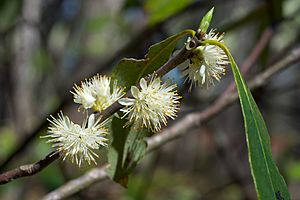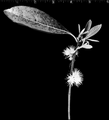Symplocos tinctoria facts for kids
Quick facts for kids Symplocos tinctoria |
|
|---|---|
 |
|
| Conservation status | |
| Scientific classification | |
| Genus: |
Symplocos
|
| Species: |
tinctoria
|
The Symplocos tinctoria is a cool plant! It's also known as the common sweetleaf, horse-sugar, or yellowwood. This plant can be a shrub or a tree. It can lose its leaves in winter (deciduous) or keep them all year (evergreen).
You can spot this plant by looking at its twigs. The inside part of the twigs, called the pith, has small sections like tiny rooms. Its leaves don't smell much when you crush them. The leaves also have fine hairs on the underside.
This plant can grow quite tall, up to 17 meters (about 56 feet). Its trunk can be as wide as 36 centimeters (about 14 inches) across. The newest twigs are usually less than 3 millimeters wide. The buds at the end of the branches have a sharp tip.
The leaves are usually 7 to 15 centimeters long. Their edges are mostly smooth, but sometimes they have a few small teeth near the top. The leaves taste sweet, though older leaves might not taste as strong.
When the sweetleaf flowers, it's very noticeable! The flowers open before new leaves grow. They are fragrant and grow in clusters. These clusters appear where last year's leaves were, or just above where leaves have fallen off. The petals are a creamy yellow color. Each flower has one pistil, which is the part that makes seeds.
After flowering, the plant produces fruits. These fruits are like small plums, called drupes. They are about 8 to 12 millimeters long and are nearly cylinder-shaped. They have a thin outer layer and a hard stone inside with one seed. The tip of the fruit often still has parts of the sepals, which are like small leaves that protect the flower bud.
Animals like to eat the leaves of the sweetleaf plant. People can also get a yellow dye from its bark and leaves. The sweetleaf flowers from March to May.
Where the Sweetleaf Grows
You can find the sweetleaf plant in many places, but it's not super common. It often grows by itself, not in big groups. It likes thin or dense woods on slopes and bluffs. It also grows in broad-leaf woods with sandy soil, along streams, and on stable sand dunes.
The sweetleaf is the only plant of its kind (genus Symplocos) that grows in North America. You'll mostly find it in the southeastern parts of the United States.
What the Sweetleaf Is Used For
In the past, people used to make a yellow dye from the bark and leaves of the sweetleaf plant. Early American settlers also used the bark as a tonic, which is a type of medicine to make you feel stronger.
Images for kids








